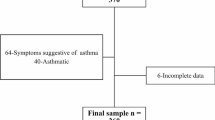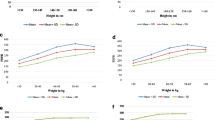Abstract
Objective :Maximal Expiratory Pressure (MEP) is a powerful indicator for respiratory muscle strength, which reflects the ability of a person to cough effectively.Methods: The present study was designed on healthy respiratory symptom free children of a Residential – Sainik (50) and Non-Residential (44) school children (aged 12-14 yrs) of Bijapur, to evaluate MEP in relation to their physical anthropometry. MEP (mm Hg) was determined by using a modified Black’s apparatus, which is significantly higher in Residential-Sainik school children in comparison to Non-Residential school children (p<0.01).Results: In both groups, MEP showed positive correlation with height (Residential, r=0.72, p<0.001; Non-Residential, r=0.73, p<0.001); weight (Residential, r=0.73, p<0.001; Non-Residential, r=0.69, p<0.001), BSA (Residential, r=0.79, p<0.001; Non-Residential, r=0.72, p<0.001) and BMI (Residential, r = 0.48, p<0.01; Non-Residential,r=0.34, p<0.05), and also revealed a higher MEP in children with greater chest expansion.Conclusion: Possibly, routine physical exercise in residential Sainik school children attribute to their better respiratory muscle strength.
Similar content being viewed by others
References
Rimmer KP, Whitelar WA. The respiratory muscles in multicore myopathy.Am Rev Respir Dis 1993; 148:227–231.
Tanturi C, Massud M, Piperno Ret al. Control of breathing and respiratory muscle strength in patient with multiple sclerosis.Chest 1994; 105:1163–1170.
Sridhar MK, Anderson K, Weir A, Moran F, Banhan SW. Diaphragmatic Paralysis in motor neurone disease: use of noninvasive investigative and therapeutic technique.Br J Clin Prac 1994; 48:156–157.
Arora NS, Rochester DF. Effect of body weight and muscularity on human diaphragm muscle mass,thickness and area.J Appl Physiol 1982; 52: 64–70.
Evans SA, Watson L, Hawkins M, Cowley AJ, Johnston IDA, Kinnear WJM. Respiratory muscle strength in chronic heart failure.Thorax 1995; 50: 625–628.
Syabbalo N. Assessment of respiratory muscle function and strength.Postgrad Med J 1998; 74(8): 208–215.
Weiner P, Suo J, Fernandes E, Cherniak RM. Efficiency of respiratory muscle in healthy individuals.Am Rev Respir Dis 1989; 148: 392–396.
Berry JK, Vitalo CA, Larson JL, Patel M, Kim MJ. Respiratory muscle strength in older adults.Nur Res 1996; 45:154–159.
O’Donohue WJ Jr., Baker JP, Bell GM, Muren O, Parker CL, Patterson JL Jr. Respiratory failure in neuromuscular disease. Management in a respiratory intensive care unit.JAMA 1976; 235: 733–573.
Sahebjami H. Dyspnea in obese healthy men.Chest 1998; 114: 1373–1377.
Maruthy KN, Vaz M. The development and validation of a digital peak respiratory pressure monitor and its characteristics in healthy human subjects.Indian J Physiol Pharmacol 1999; 43 (2): 186–192.
Lohman TG, Roche AF, Martorll R. Anthropometric standardization Reference manual. Champaign, Illinois: Human Kinetic Books, 1988.
Steele RGD, Torrie JH.Principles and Procedure of Statistics with Special Reference to the Biological Sciences, 4th edn, New York; McGraw Hill Book Co; 1980; 183–193.
Arora NS, Rochester DF. Respiratory muscle strength and maximal voluntary ventilation in undernourished patients.Am Rev Respir Dis 1982; 126: 5–8.
Guleria R, Jindal SK. Normal maximal expiratory and inspiratory pressure. In healthy teenagers.J Assoc Phy Ind 1992; 40: 108–109.
Wilson SH, Cook NT, Edwards RTH, Spiro SG. Predicted normal values for maximal respiratory pressures in Caucasian adults and children.Thorax 1984; 39: 535–538.
Cook CD, Mead J, Orgalesi MM. Static volume pressure characteristics of Respiratory system during maximal efforts. /Appl Physiol 1993; 19: 1016–1022.
Ukyub TT, Vaz M. The characteristics and determination of maximal expiratory pressure in young healthy Indian males.Indian Physiol Pharmacol 1999; 43 (4): 435–442.
Arora NS, Rochester DF. Effect of body weight and muscularity on human diaphragm muscle mass,thickness and area.J Appl Physiol 1982; 52: 64–70.
Das KK, Dhundasi SA. Physical fitness: A longitudinal study among Muslim children of Bijapur (Karnataka).Indian Physiol Pharmacol 2001; 45(4): 457–462.
Author information
Authors and Affiliations
Corresponding author
Rights and permissions
About this article
Cite this article
Choudhuri, D., Aithal, M. & Kulkarni, V.A. Maximal Expiratory Pressure in Residential and Non-Residential School Children. Indian J Pediatr 69, 229–232 (2002). https://doi.org/10.1007/BF02734229
Issue Date:
DOI: https://doi.org/10.1007/BF02734229




